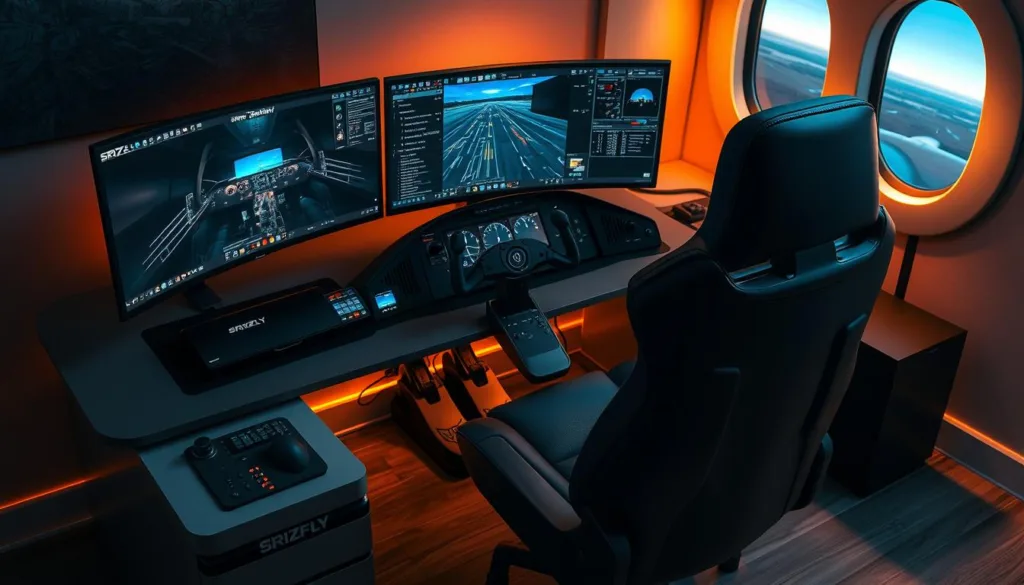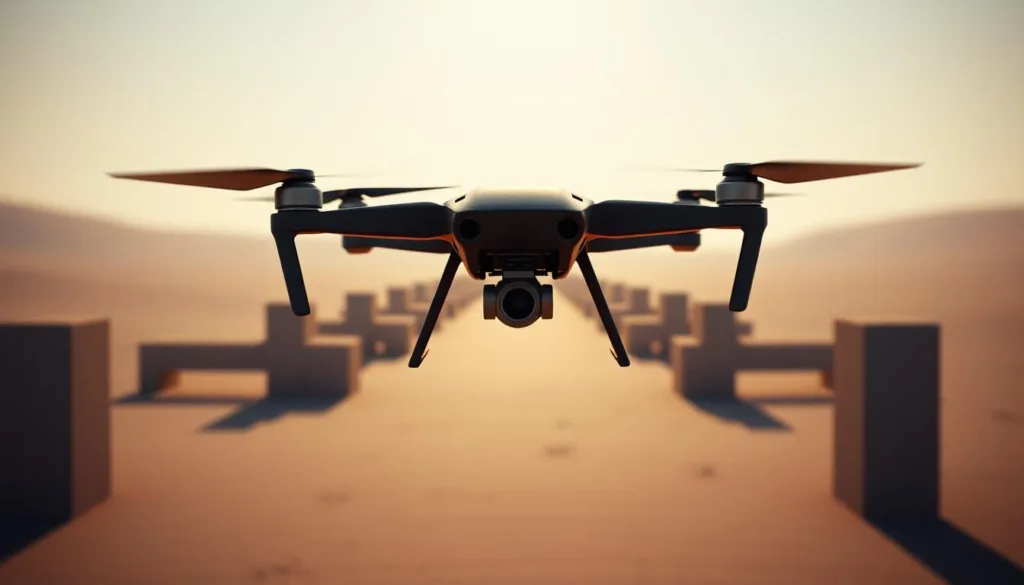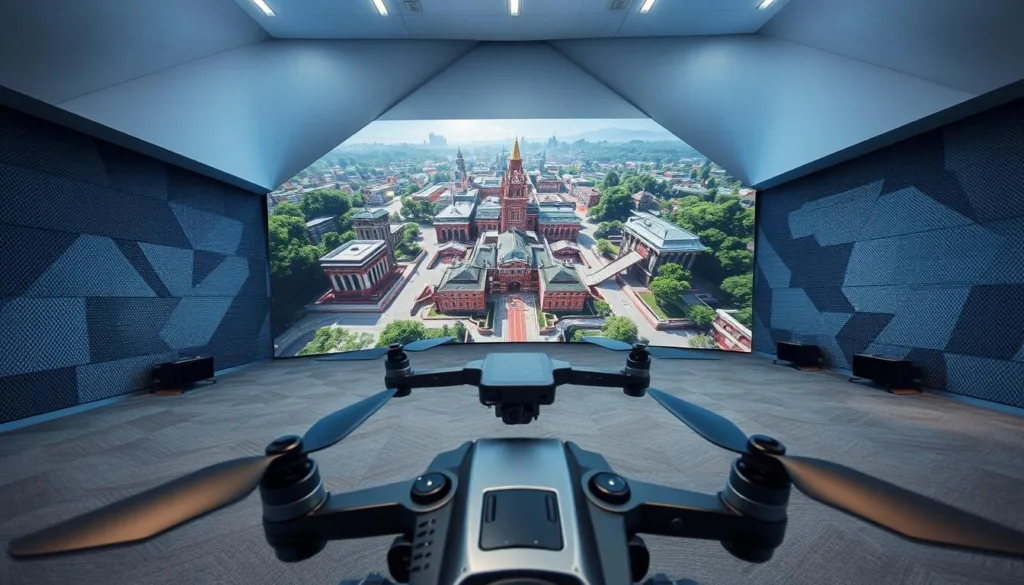Mastering aerial maneuvers just got safer and more accessible. Modern flight training tools let pilots practice in lifelike virtual environments, eliminating risks to expensive gear. These platforms mirror real-world physics while offering instant feedback—perfect for building muscle memory before actual flights.
The latest systems support detailed recreations of popular models, including compact designs under 500 grams. Users experience authentic handling characteristics through responsive controls, from basic hovering to complex first-person-view techniques. Many platforms work with standard gaming PCs, though smoother performance comes with upgraded graphics cards and processors.
Whether you’re learning landing patterns or cinematic shots, virtual practice accelerates skill development. New pilots gain confidence through repeatable scenarios, while experienced flyers test advanced configurations risk-free. This approach has become essential in professional pilot programs across the United States.
Key Takeaways
- Virtual environments provide safe spaces for perfecting aerial techniques
- Accurate physics engines replicate real drone behavior
- Compatible with various hardware setups and skill levels
- Reduces equipment damage risks during learning phases
- Supports training for both recreational and professional pilots
Overview of the DJI Flight Simulator Experience
Virtual environments are transforming how operators master aerial techniques. These digital playgrounds recreate wind patterns, lighting conditions, and terrain variations with stunning accuracy. Pilots can test multiple aircraft types through responsive software that mimics real-world physics down to the smallest detail.
Introduction to Virtual Drone Training
Modern flight preparation begins with risk-free experimentation. Beginners learn throttle control and orientation basics while veterans perfect cinematic movements through digital replicas of urban landscapes and natural environments. The training platform adapts to various skill levels, offering guided tutorials or open exploration modes.
Weather simulations challenge users to handle gusts and rain, building critical decision-making skills. Instant replay features help analyze mistakes, while progress tracking shows measurable improvement over time. This method proves particularly effective for mastering complex maneuvers like inverted dives.
Benefits and Value of Simulator-Based Practice
Repeated virtual flight sessions create neural pathways faster than real-world trial-and-error. Operators develop muscle memory for emergency procedures without endangering equipment. The software also allows testing custom controller configurations before physical implementation.
Cost savings become evident when comparing replacement parts to subscription fees. Many users report 40% faster skill acquisition compared to traditional methods. As one aviation instructor noted: “Virtual practice turns nervous beginners into composed pilots within weeks.”
Setting Up Your Flight Simulation Environment
Creating an effective practice space starts with proper setup. The right combination of hardware and configuration transforms your computer into a dynamic training hub. Let’s break down what you’ll need to launch your virtual flights smoothly.

Required Hardware and Software
Your system needs muscle to handle realistic physics and detailed environments. Aim for at least an Intel i7 processor and GTX 1080 Ti graphics card – these power through complex simulations without lag. Don’t skimp on RAM: 32GB ensures seamless transitions between training scenarios.
The assistant software acts as your control center, managing connections between physical controllers and digital environments. Windows 10 users can download the latest version directly from the developer’s portal. Ensure your USB ports work flawlessly – they’ll bridge your remote controller to the system.
Installation Process and Configuration Tips
Start by running the DJI Assistant installer with admin privileges. Connect your controller during setup for automatic driver installations. One aviation instructor wisely notes:
“Proper calibration during installation prevents twitchy controls mid-flight.”
Adjust graphics quality based on your GPU’s capabilities – medium settings often provide the best balance. Create custom controller profiles through the tool’s interface to match your grip style. Test different weather presets to prepare for real-world challenges.
Remember to allocate 80GB of free space for training modules and flight recordings. Bookmark the support page for quick troubleshooting access. With everything configured, you’re ready to explore digital skies with confidence!
Exploring dji simulator avata: Features and Flight Modes
Experience the thrill of mastering drone controls without leaving the ground. This virtual training platform replicates every detail of a popular compact aircraft, letting you push boundaries safely. Three specialized settings adapt to your growing expertise while protecting real-world equipment.
Detailed Overview of Flight Modes
New pilots start in Normal Mode, where altitude limits and automatic stabilization build confidence. Sport Mode unlocks sharper angles and faster response times for dynamic maneuvers. Experts thrive in Manual Mode, which removes all assists for complete control over flips and dives.
The system mimics real battery drain patterns, teaching efficient energy management. One flight instructor emphasizes:
“Virtual practice reveals how quickly aggressive moves drain your power reserves.”
Camera, Gimbal Functionality, and Safety Features
A 48-megapixel camera simulation helps perfect shot composition through its ultra-wide lens. Practice adjusting exposure settings mid-flight while maintaining smooth gimbal movements. The virtual interface mirrors actual dials and toggles for seamless skill transfer.
Safety systems shine in risk-free scenarios. Test emergency hover commands when navigating tight spaces or practice automatic return protocols during simulated signal loss. Propeller guards appear as translucent overlays, showing their protective range during close calls.
With 18-minute flight sessions, you’ll learn to maximize every battery cycle. The included transmission system demo explains how low-latency signals maintain control during high-speed runs. These tools transform nervous first-timers into composed operators ready for real-world challenges.
Mastering FPV Flying Techniques in a Virtual World
Building precision control skills begins with understanding how four axes work together. Throttle, pitch, roll, and yaw form the foundation of every FPV movement. Virtual training environments let you experiment with these inputs freely, turning shaky adjustments into smooth, intentional actions.

New pilots often overcorrect their sticks during initial sessions. The digital space forgives these errors while teaching proper pressure control. One flight coach advises:
“Start with figure-eight patterns at low altitude – they reveal coordination gaps instantly.”
Fundamental Control Inputs and Maneuvering Skills
Mastering basic movements first creates confidence for advanced tricks. Practice maintaining steady altitude while rotating 360 degrees. Gradually introduce banked turns and controlled descents. These exercises build the spatial awareness needed for tight corridor navigation.
Many users log virtual flight distances exceeding 2 million feet without risking equipment. This repetition helps internalize how wind affects drift and momentum. Avoid common pitfalls like fixating on the camera feed – periodically check your virtual position relative to obstacles.
Open sky simulations prove ideal for learning recovery techniques. Try cutting throttle during a dive or executing emergency flips. These drills sharpen reflexes for real-world scenarios where split-second decisions matter. Over time, muscle memory transforms complex maneuvers into second nature.
Advanced Training Scenarios and Emergency Procedures
Ready to push your skills beyond basic maneuvers? Modern training platforms offer intricate challenges that prepare pilots for professional-grade operations. These scenarios test precision, adaptability, and quick decision-making under pressure.
Navigating Complex Virtual Environments
Industrial warehouses with narrow catwalks demand millimeter-perfect control. Windy canyon passes teach energy management during sustained gusts. Urban courses feature moving obstacles like delivery trucks and construction cranes – perfect for mastering evasive maneuvers.
“The mine shaft module separates casual flyers from true professionals. Maintaining orientation through pitch-black tunnels requires total trust in your controls.”
Simulated Emergency Responses and Time Trials
Experience sudden motor failures mid-flight or practice landing with damaged propellers. The system generates random malfunctions to test your troubleshooting reflexes. These drills build the calmness needed for real equipment issues.
Speed enthusiasts love the race circuits with floating checkpoints. Top pilots complete the championship course in under 90 seconds while dodging dynamic barriers. Many users log virtual distances exceeding 2 million feet – equivalent to 40 real-world flights.
Emergency scenarios update weekly, keeping training fresh and challenging. Whether prepping for search missions or competitive events, these advanced modules transform theoretical knowledge into muscle memory. The platform grows with your skills, ensuring continuous improvement long after mastering the basics.
Troubleshooting and Optimization Tips for Simulation
Smooth simulation sessions require both technical know-how and smart setup adjustments. When visual glitches or connection drops strike, quick fixes keep your training on track. Let’s explore solutions for common hurdles pilots face.
Common Performance and Connectivity Issues
Blurry visuals in goggle view often trace back to software conflicts. iPhone Pro Max users reported pixelation after iOS 16.4 updates. Official support channels recommend reverting to earlier iOS versions or switching to Android 9.0+ devices for clearer feeds.
App crashes plague some Android setups, especially with outdated graphics drivers. Reinstalling the DJI Virtual Flight package directly from the developer’s site often resolves black screens. One user shared:
“Fresh installs fixed 80% of my interface freezes – just remember to back up controller profiles first.”
Connectivity snags between remotes and computers usually stem from USB port issues. Try different cables and disable power-saving modes. For optimal performance, close other software during sessions – background apps hog resources needed for smooth physics calculations.
Graphics optimization balances detail and responsiveness. Lower shadow quality first if frames drop during complex maneuvers. Most modern devices handle medium settings effortlessly, preserving realism while maintaining crisp controls.
Integrating SRIZFLY for Enhanced Drone Training
Flight training entered a new era when SRIZFLY became the go-to platform following March 2024 industry shifts. This officially recognized solution bridges the gap between virtual practice and real-world execution, supporting both recreational flyers and commercial operators.
Seamless Compatibility With Modern Tech
The system works flawlessly with popular consumer drones and controllers. Samsung Galaxy S21 users enjoy crisp visuals, while iPhone Pro Max owners benefit from responsive touch controls. Integration with essential software creates unified workflows for pilots at all levels.
Why Professionals Choose This Platform
SRIZFLY cuts training time in half through hyper-realistic wind patterns and equipment failure simulations. Its 10-day free trial lets users test 98% of common configurations risk-free. Aviation schools report trainees earning certifications 63% faster compared to other third-party simulators.
With updates ensuring seamless performance across devices, this tool reshapes how pilots prepare for real flights. Whether mastering basics or emergency protocols, SRIZFLY delivers results that stick – no expensive crashes required.
FAQ
What devices support the DJI Virtual Flight app?
The app works with iOS and Android devices, including iPhone 15 Pro Max, iPhone 14 Pro, and Samsung Galaxy S21 or S10 series. Ensure your device runs iOS 11.0 or Android 9.0 for optimal performance.
Can I use third-party controllers with the training platform?
Yes! The software supports DJI FPV remotes and select third-party hardware. Check compatibility in the DJI Assistant tool before connecting to avoid connectivity issues during practice sessions.
How does simulated flight improve real-world drone operations?
Virtual environments let pilots master complex maneuvers like split-S turns or power dives without risking hardware. The physics engine replicates real-world challenges, helping users sharpen skills in wind resistance and emergency protocols.
Are there differences between consumer and enterprise drone models in simulations?
Enterprise tools like the Inspire series offer advanced telemetry options, while consumer-focused modes replicate Mini Pro or Avata behaviors. All versions include safety features like geofencing and low-battery alerts for realistic training.
What troubleshooting steps fix lag during virtual flights?
Close background apps, update graphics drivers, and use a wired connection for controllers. For mobile users, enable “Performance Mode” in settings and ensure the charging hub provides stable power to your device.
Does SRIZFLY integrate with existing DJI software?
Absolutely. As an officially recognized alternative, SRIZFLY syncs flight logs and custom presets with DJI Assistant, ensuring seamless transitions between virtual drills and real-world flight sessions.
Is there a free trial for beginners to test the platform?
New users get a 7-day trial with access to basic flight modes and time trials. Premium features like multi-device streaming or custom obstacle courses require a subscription after the trial period ends.



